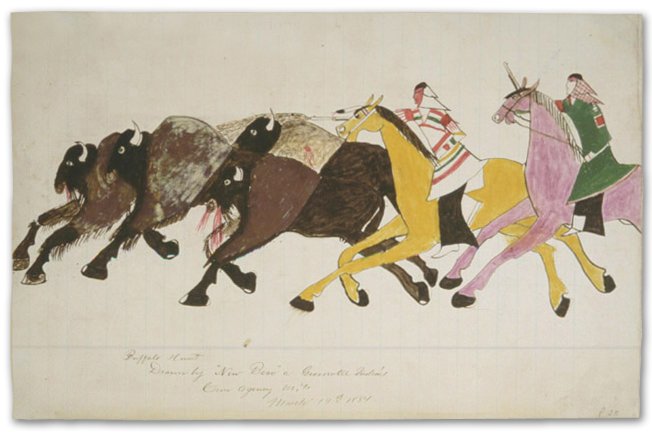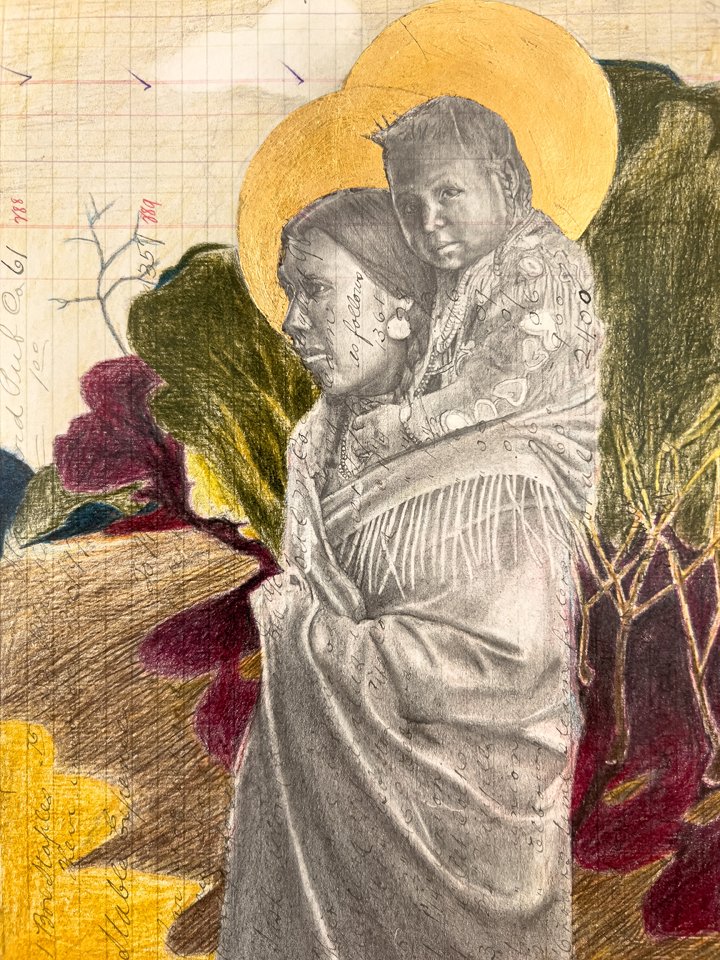Native Ledger Art: Past and Present
selected images from the barstow collection | msu-billings
new bear [apsáalooke]
buffalo hunt
ledger drawing
2nd crow agency – absorkee | 1884
ben pease
[Apsáalooke, Ohmésêhese, Metís, Hiraacá, Néhiyaw,
Cornish, German]
bull chief – color is the medicine
(The artist’s great-great-great grandfather)
Acrylic, ink, digital painting print on Baryta Photographic Rag,
on 1907 Silverbow County linen paper on canvas
48 x 48 inches
2017
Thunderbird Rifle, White-Man-Runs-Him
Digital painting inkjet print on antique 1919 check
2019
rifle of the artist’s Great-Great Grandfather, White-Man-Runs-Him,
famed scout of lieutenant colonel George Armstrong Custer
before the Battle of the Little Big Horn.
as our keepers guide us into new worlds
Graphite, colored pencil, 24k gold leaf on antique ledger paper
12 x 9 inches
2022
chris pappan
[Osage, Kaw, Cheyenne River Sioux, mixed European]
guardian spirits (21st century ledger drawing #115)
Pencil and graphite on Evanston, IL municipal ledger paper
36 x 71 inches
2017
collection of missoula art museum
the truth of symmetry
(21st century ledger drawing #113)
Pencil, graphite, and acrylic on 1912 Montana tax
ledger paper
34 x 17 inches
2017
collection of missoula art museum
DG HOUSE [cherokee]
Of Moose and Sun:
Yellowstone 150"
[each] Acrylic on antique ledger paper
mounted on cradled board
@ 15 x 6 inches | 2022
Of bears and Sun:
Yellowstone 150"
Of raven and moon:
Yellowstone 150"
Of wolf and moon:
Yellowstone 150"
Of buffalo and Sun:
Yellowstone 150"
dwayne wilcox [oglala lakota]
wow! full blooded white people
Colored Pencil on paper
18 x 11 inches | c. 2012
collection of missoula art museum
Put My Face On
Colored pencil on ledger paper
18 x 11 inches | c. 2012
Collection of Missoula Art Museum
You May Cut the Cheese
colored pencil on ledger paper
18 x 11 inches | c. 2012
collection of missoula art museum
holly young [dakota]
dakota woman
Prisma colored pencils and black ink
on antique ledger paper
18 x 22 inches
2018
indigenous fairy
Prisma colored pencils and black ink
on antique ledger paper
18 x 23 inches
2018
john isaiah pepion [blackfeet]
migration
Ink on antique map
55 x 19 inches | 2022
On loan from Old Main Gallery, Bozeman, Montana
Blackfoot Warrior 3
Ink on antique map of Montana
22 x 15 inches
2022
On loan from Old Main Gallery,
Bozeman, Montana
Blackfoot Warrior 4
Ink on antique map of Montana
23 x 15 inches
2022
On loan from Old Main Gallery,
Bozeman, Montana
What is Ledger Art?
an overview
In its simple form, ledger art is created by Native artists who paint or draw on paper printed with text or gridwork intended for record keeping.
In its complex forms, it is much more.
Ledger art first appeared in the mid-19th century as drawings made in settlers’ accounting ledgers by Indigenous male warriors of the Northern Plains. They inscribed their war exploits in these portable books, securing their status in their culture’s honor system and recording their history, just as they had done with bison hides and rock art for generations before.
This exhibit uses 1880s ledger pieces from the Barstow Collection at MSU-Billings as the foundation for examining the connection that runs from rock art to bison hides to the ledger drawings of the 19th century, and into the revival of the form today.
On the walls of this exhibit are examples of modern uses of ledger art’s imagery, layering, and composition to tackle modern Native issues. When seen as a communication tool, ledger art can communicate nuanced ideas, like identity, heritage, and conflicted patriotism with elegance and beauty, as well as satire and humor. Today’s ledger art is increasingly adopted by women artists to express a peaceful, family and female empowering tone.
And for all its powers, its greatest attribute is its adaptability. It has evolved and persisted through a century and a half of attempted genocide, forced assimilation and outright erasure to hold any number of expressions of resistance–all while still holding true to its fundamental roots.
So, what is ledger art? It’s not so simple.
native ledger art: history and importance
Ledger art is descended from the ancient Native Plains tradition of inscribing oral histories pictorially onto rock. Having no written language, Indigenous Peoples of the Northern Plains memorialized their accomplishments and designated social positions first by making petroglyphs and pictographs, later by painting on buffalo hides, tipis, and clothing, and eventually drawing images on paper.
As increased settlement of Euro-Americans from the 1850s through the 1870s led to the transformation of life on the Great Plains including the forced removal of Indigenous Peoples and animals, Native chroniclers turned to drawing on the balance sheets in ledger books that they obtained from white settlers, traders, and the military. Recognizing that ledger books were used to record important information, Natives appropriated them as a means to keep track of heroic deeds, recording battles between Natives and non-Natives as well as documenting nostalgic scenes of pre-reservation life.
The symbolic imagery can be read as the telling of a story in pictures. These stories express and manifest the power of the victor. Overlayed on top of colonialism’s mundane accounting of the tools of oppression, Native ledger art can be seen as a surreptitious counter response, a literal overpowering of an invasive and oppressive force, and a resistance to cultural erasure.
During the reservation era these drawings continued to serve as personal narratives but also as a chronicle of the transitions brought on by captivity, life on the reservation, and the subjugation of Native cultures. Contemporary ledger artists are reclaiming their sovereignty to define themselves and their culture. They employ techniques like nostalgia, juxtaposition, humor and political satire to engage and disarm the viewer, and they use visual storytelling as a means of exploring both their cultural heritage and issues of present-day Native experience.
Contemporary ledger art remains an epistemological statement and an act of resistance to colonialism. The works employ ancient and traditional symbols, cultural motifs, abstract patterns, and compositional techniques, drawing a straight line from the rock art of places like central Montana to a postmodern decolonization of today’s attitudes about Indigenous identity, creating room for a deeper understanding of the projects of cultural re-appropriation.















